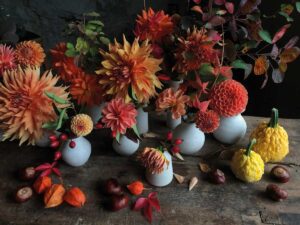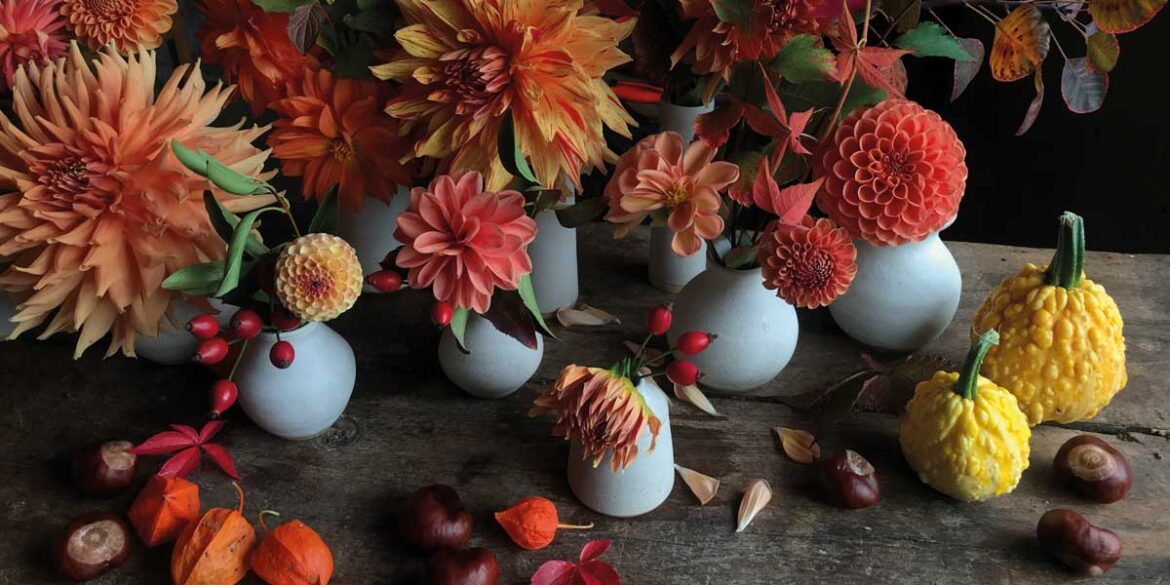Anna Taylor, owner of Anna’s Flower Farm, shares what’s going on in the garden
The next few weeks are for working on gifts for future me. From here until the midwinter solstice, the gardening year reaches its busiest period: clearing and composting the remnants of summer while preparing with planting for the next.
I love the liminal space between the seasons. A frost may or may not have descended on the gardens by now. This is when dahlias and half-hardy annuals will collapse, surrendering to its touch overnight. If temperate nights continue, flowering slows as they age gracefully.
 Either way, the gloves are on and the tools are out. With planting shrunken, there is space to get into the borders. I start by lifting and splitting perennials. Spring-flowering ones are perfect for this treatment now – including hellebores, alchemilla mollis and epimedium, but also late-summer lysimachia, anemone and verbena will benefit. A good rule of thumb is to divide before or after active growth.
Either way, the gloves are on and the tools are out. With planting shrunken, there is space to get into the borders. I start by lifting and splitting perennials. Spring-flowering ones are perfect for this treatment now – including hellebores, alchemilla mollis and epimedium, but also late-summer lysimachia, anemone and verbena will benefit. A good rule of thumb is to divide before or after active growth.
I split mainly in the autumn so plants have time to anchor themselves before the winter, producing better growth next year.
Then, it’s the great spring bulb hiding game. I must admit, it’s the least rewarding task at the time – burying bulbs one by one from a big basket with nothing to show for your efforts. But spring brings delightful surprises; I am always so pleased when they emerge, with bulbs chosen for every month. I often chastise myself for not planting more! I recommend narcissus varieties from late February through May, since they will return year after year even if you cut the flowers for arranging. Also consider leucojum, or snowflakes, which resemble giant snowdrops and are equally as cheerful later in the spring.
For future presents, I also plant up pots of bulbs for tables outside and in. Indoors, I plant narcissus ziva for my sideboard and friends. Planted in terracotta pots with humus-rich soil, silver birch branches for support around the bulb and a dressing of emerald moss, these will flower in six to eight weeks and fill your home with fragrance.
 Stagger the planting for uninterrupted displays. Outdoors, I love narcissus: the dwarf, golden bells and arctic bells varieties are so pretty in pots or troughs, either on a windowsill or wherever you see them close up. Muscari (little grape hyacinths), scillas and iris reticulata come in various colours, too. I prefer Peter Nyssen bulbs as they are never treated with neonicotinoids – a widely used pesticide in agriculture to keep aphids and sap-sucking insects off plants. This also affects many pollinators and more welcome insects.
Stagger the planting for uninterrupted displays. Outdoors, I love narcissus: the dwarf, golden bells and arctic bells varieties are so pretty in pots or troughs, either on a windowsill or wherever you see them close up. Muscari (little grape hyacinths), scillas and iris reticulata come in various colours, too. I prefer Peter Nyssen bulbs as they are never treated with neonicotinoids – a widely used pesticide in agriculture to keep aphids and sap-sucking insects off plants. This also affects many pollinators and more welcome insects.
Of course, none of us want aphids or sap-sucking insects, but ladybirds and other wildlife certainly do so don’t chop all your plants down this autumn. Leave some stems and shape to your beds; grasses, echinops and echinacea provide lovely winter silhouettes and scaffolding for sparkling, dew-laden cobwebs. They also offer shelter for overwintering insects that will feast on the pests next year.
Collect leaves off lawns and paths and save these in bags or a chicken wire basket to rot down, creating absolute gold to add to compost next year for potting on. However, leave those leaves on beds or borders, where they will act as mulch and be rich food for worms. Over the winter months, the worms add valuable organic matter, which will in turn increase the nutrient and moisture retention of the soil.
This is a beautiful month for gardening and preparing for next year, with little jobs easily done in cooler yet clement weather. Time spent now is worth twice that in the spring, when light and temperature levels mean rapid (weed) growth. That knowledge makes the jobs even sweeter.

